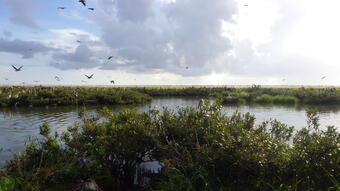Natural Resource Damage Assessment (NRDA) Program-Louisiana Outer Coast Restoration: North Breton Island Component-Monitoring and Adaptive Management Active
In order to enhance habitat for nesting Brown Pelicans, terns, Black Skimmers, and gulls, the USFWS has contracted with USGS to conduct project monitoring on North Breton Island from FY23 to FY31. Monitoring conducted by USGS will facilitate evaluation of habitat characteristics and determine restoration success or need for adaptive management.

The Science Issue and Relevance: After the Deepwater Horizon oil spill, federal and state agencies including the Department of Commerce, the Department of the Interior, the U.S. Environmental Protection Agency, the U.S. Department of Agriculture, and the five Gulf States of Alabama, Florida, Louisiana, Mississippi and Texas, formed a Trustee Council. The members of the Trustee Council work together to collectively assess the injuries caused by the spill and to select the appropriate restoration measures to compensate the public for the injury to, and lost use of, the resources each of the Trustees hold in trust for the public.
As part of the restoration efforts the Department of Interior (specifically, U.S. Fish and Wildlife Service or USFWS) is the implementing trustee on the North Breton Island Restoration component of the larger Louisiana Outer Coast Restoration Project. North Breton Island is part of the USFWS National Wildlife Refuge System. Restoration efforts, completed in January 2022, built barrier island habitats including dunes, beaches, and back barrier marsh. The main objective of the project is to enhance habitat for nesting Brown Pelicans, terns, Black Skimmers, and gulls. USFWS has contracted with USGS to conduct project monitoring on North Breton Island from FY23 to FY31. Monitoring conducted by USGS will facilitate evaluation of habitat characteristics and determine restoration success or need for adaptive management.
Methodology for Addressing the Issue: USGS WARC leads monitoring efforts associated with vegetation survival and habitat mapping. USGS St. Petersburg Coastal and Marine Science Center leads data collection to understand the evolution of island geomorphology post restoration.

Monitoring methods are dictated by the Louisiana Outer Coast Restoration Project Monitoring and Adaptive Management plan and are implemented consistently across Louisiana Outer Coast project components (four islands). USGS’ involvement monitoring vegetation, habitat and island geomorphology focus on North Breton Island. Methods are consistent with those outlined in the Monitoring and Adaptive Management Procedures and Guidelines Manual Version 2.0
Future Steps: Restoration techniques and data collections associated with North Breton Island may influence the design and implementation of future restoration efforts throughout the Chandeleur Islands complex.
In order to enhance habitat for nesting Brown Pelicans, terns, Black Skimmers, and gulls, the USFWS has contracted with USGS to conduct project monitoring on North Breton Island from FY23 to FY31. Monitoring conducted by USGS will facilitate evaluation of habitat characteristics and determine restoration success or need for adaptive management.

The Science Issue and Relevance: After the Deepwater Horizon oil spill, federal and state agencies including the Department of Commerce, the Department of the Interior, the U.S. Environmental Protection Agency, the U.S. Department of Agriculture, and the five Gulf States of Alabama, Florida, Louisiana, Mississippi and Texas, formed a Trustee Council. The members of the Trustee Council work together to collectively assess the injuries caused by the spill and to select the appropriate restoration measures to compensate the public for the injury to, and lost use of, the resources each of the Trustees hold in trust for the public.
As part of the restoration efforts the Department of Interior (specifically, U.S. Fish and Wildlife Service or USFWS) is the implementing trustee on the North Breton Island Restoration component of the larger Louisiana Outer Coast Restoration Project. North Breton Island is part of the USFWS National Wildlife Refuge System. Restoration efforts, completed in January 2022, built barrier island habitats including dunes, beaches, and back barrier marsh. The main objective of the project is to enhance habitat for nesting Brown Pelicans, terns, Black Skimmers, and gulls. USFWS has contracted with USGS to conduct project monitoring on North Breton Island from FY23 to FY31. Monitoring conducted by USGS will facilitate evaluation of habitat characteristics and determine restoration success or need for adaptive management.
Methodology for Addressing the Issue: USGS WARC leads monitoring efforts associated with vegetation survival and habitat mapping. USGS St. Petersburg Coastal and Marine Science Center leads data collection to understand the evolution of island geomorphology post restoration.

Monitoring methods are dictated by the Louisiana Outer Coast Restoration Project Monitoring and Adaptive Management plan and are implemented consistently across Louisiana Outer Coast project components (four islands). USGS’ involvement monitoring vegetation, habitat and island geomorphology focus on North Breton Island. Methods are consistent with those outlined in the Monitoring and Adaptive Management Procedures and Guidelines Manual Version 2.0
Future Steps: Restoration techniques and data collections associated with North Breton Island may influence the design and implementation of future restoration efforts throughout the Chandeleur Islands complex.

